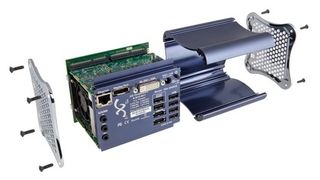The Xi3 PC: what you need to know
Is this the most energy efficient PC ever?
Adjust these two sliders and the high capital cost of each Xi3 almost completely counters the operational benefits. Furthermore, by default, it's assumed that a traditional desktop uses 200W of power - there's no reason why a cheap, new, modern corporate machine for email and cloud access should actually consume half of that.
On top of which, many corporates are encouraging employees to 'bring their own device' as a way of cutting costs and reducing power consumption, rather than refitting entire offices. Applications like Avaya's Aura Flare can put a fully functioning contact centre interface with telephony built in onto an Android tablet or iPad.

Green IT experts that TechRadar quizzed about Xi3 all agreed that the cost calculation isn't convincing enough for most companies, and that the expectation of being able to run four desktops from a single Athlon X2 seemed ambitious too. In addition, the fact that Xi3 is a closed and proprietary system from a young company makes it hard to buy into when an open platform is easier and better guaranteed to support in the long term.
Christine Headford is CIO of CO2High Ltd, a company that specialises in measuring firms' carbon footprint and helping to reduce it.
"The cost comparison goes in the Xi3's favour based on being able have four users, 24 hour operation (unlikely in an office environment) and that software licensing is cheaper on thin client," says Headford, "If you increase the spec to allow for four users, adjust to office hours and accept that software manufacturer will not be willing to reduce their income for thin client, the savings are much less convincing: down to less than 5% over 5 years."
It's early days for Xi3, though, and while it's not certain that this particular machine will take off yet, there's definitely room for an improved, cheaper version in the future. It's a reminder that next time your IT support team come round to repair or replace your desktop computer, they may not be quite living in a 'post-PC' era, but they do have options.
Are you a pro? Subscribe to our newsletter
Sign up to the TechRadar Pro newsletter to get all the top news, opinion, features and guidance your business needs to succeed!
